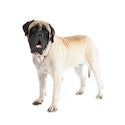Mastiff Dog Breed

- Size
- Giant
- Height
- Males – at least 30 inches at the shoulders, Females – at least 27.5 inches at the shoulders
- Weight
- Males – 160 to 230 pounds, Females – 120 to 170 pounds
- Coat
- Short
- Color
- Fawn, apricot or brindle
- Energy
- Low
- Activities
- Agility, Drafting, Obedience
Bred in England as a watchdog for more than 2,000 years, the Mastiff is a powerful yet docile breed.
Temperament
Grand, dignified as well as good-natured, the Mastiff is a home-loving companion ready and able to protect his people.
Although they are well suited for suburban or country life, Mastiffs don’t need lots of exercise and can also enjoy a home without a backyard. Daily walks of a mile or two will help support an adult Mastiff’s physical and psychological health.
Characteristics
Members of the Working group, Mastiffs are giants with thickly muscled bodies and large, broad heads. Male Mastiffs can outweigh many grown men. Their faces are masked in black, with a wrinkled forehead that adds a touch of wisdom to their benevolent expression.
Lifespan
6 to 10 years
Colors
The colors of the Mastiff’s coat include fawn, apricot and brindle stripes, with a mask of black covering the face.
Shedding
The Mastiff is a seasonally shedding breed, but his short, dense coat makes grooming easy. It requires only a quick brushing every few days, and more frequent grooming with a strong comb once or twice a year during periods of shedding.
The ears and deep wrinkles around the face need to be kept clean. It must also be mentioned that Mastiffs do drool. So pet owners need to keep cloths handy to wipe up!
Health
Mastiffs can be prone to a number of health issues such as seasonal allergies, eye anomalies, heart disease, cancer, eye and hip dysplasia, von Willebrand’s disease, degenerative myelopathy, and epilepsy. Responsible breeders will screen for these conditions.
Because of their deep chests, Mastiffs can also experience bloat, which is a life-threatening condition.
Best Dog Food for Mastiffs Dogs & Puppies
As a giant breed, Mastiffs may benefit from a giant or large breed dog food. For Mastiffs who need help with weight management, consider a healthy weight formula.
Mastiff puppies should eat a large breed puppy food for their first year of life to aid in their growth and development.
History
The breed now known as Mastiff is an ancient breed of Britain. In fact, Julius Caesar encountered them when he invaded Britain in 55 B.C. The emperor was impressed by these magnificent dogs, and Mastiffs were later brought to Roman arenas to fight wild animals and gladiators.
During the Middle Ages, Mastiffs were employed as hunters of big game, guardians of estates and war dogs. In 1415, they helped British soldiers battle the French at the Battle of Agincourt.
The Mastiff breed was recognized by the American Kennel Club (AKC) in 1885. However, by the end of World War II England had lost many lives and almost the entire Mastiff breed line. American breeders came to the rescue, sending dogs from quality British stock back to England.
While Mastiffs today are gentler than their ancestor warriors, the breed is still known for its unfailing courage.
Facts
- The Mastiff is mentioned in the writings of Chaucer, who described the breed as “large as a steer.”
- While the British Mastiff breed line is more than 2,000 years old, other related breed lines are even older. Drawings of typical Mastiffs have been found on Egyptian monuments dating to about 3,000 B.C.
- Famous Mastiff owners include King Henry VIII, Marlon Brando and Bob Dylan.